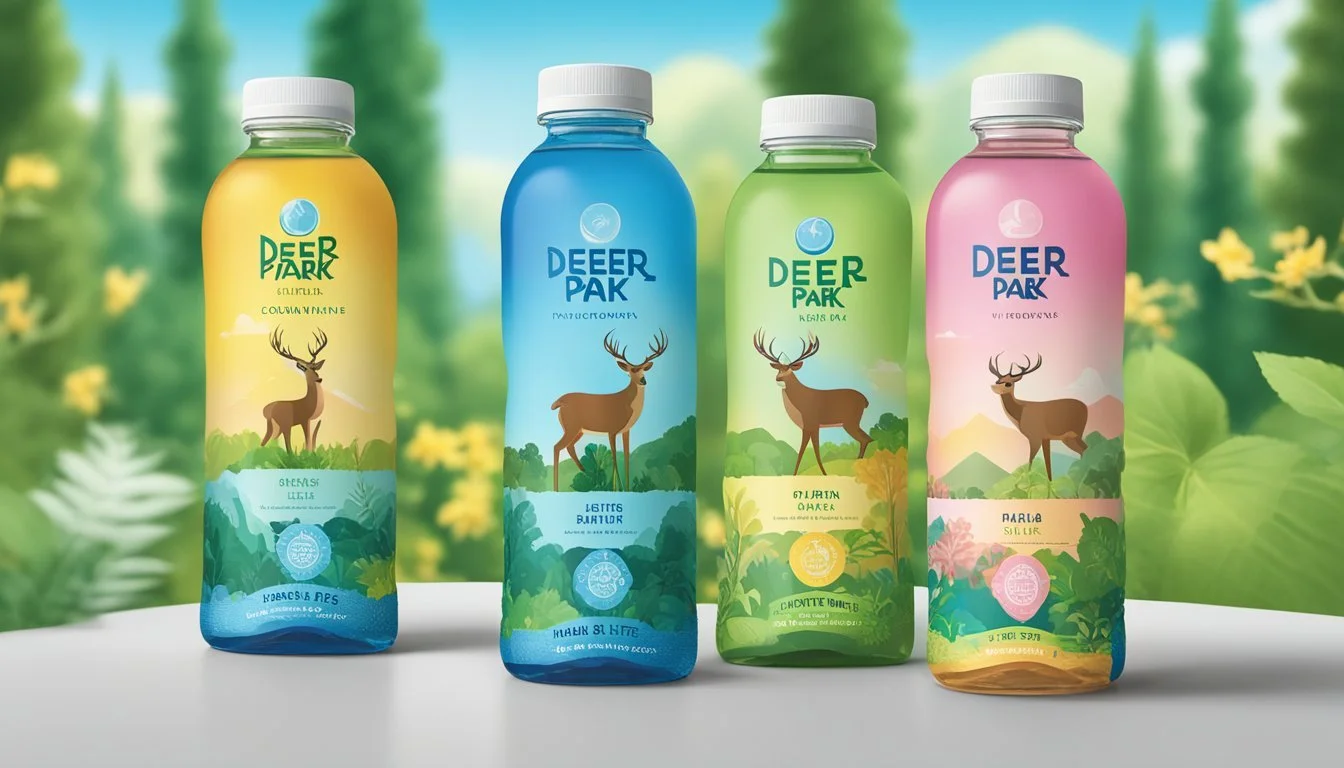Deer Park vs. Pure Life
Comparing Quality and Taste
Choosing the right bottled water can make a significant difference in terms of taste and health benefits. Deer Park, known for its 100% natural spring water, has established a reputation for providing crisp and clean hydration. Pure Life, on the other hand, offers a different experience, being a product of the largest bottled water corporation in the world.
Deer Park stands out for its natural spring sources and the assurance of consuming water free from added chemicals or artificial sweeteners. For consumers who value natural ingredients and a more authentic taste, this makes Deer Park a compelling choice. Pure Life, despite its wide availability and substantial market presence, often garners mixed reviews, with many pointing to its average taste and the corporation's reliance on treated water sources.
Consumers looking for a superior bottled water option would do well to weigh the distinct origins and compositions of these two brands. Both Deer Park and Pure Life occupy prominent places in the market, but a close examination reveals that those who prioritize purity and natural sources may find Deer Park to be the better option. This examination into the details of each brand's offering aims to equip you with the knowledge to make an informed decision.
The Importance of Hydration
Hydration is essential for maintaining overall health and well-being. Water, being the primary component of the human body, plays a critical role in regulating body temperature, transporting nutrients, and removing waste.
Every cell, tissue, and organ in the body requires adequate hydration to function correctly.
Consuming water helps maintain the balance of bodily fluids, essential for processes including digestion and circulation. Proper hydration ensures that vital nutrients and minerals are delivered efficiently throughout the body.
Water also contains electrolytes such as sodium, potassium, and chloride, which are vital for maintaining fluid balance and muscle function.
In addition to physical health, hydration greatly impacts cognitive function and emotional well-being. Dehydration can lead to fatigue, headaches, and impaired concentration.
It's important to remember that both natural spring waters, like Deer Park, and purified drinking waters, like Nestlé Pure Life, can help meet daily hydration needs.
Choosing the right type of water, whether for its mineral content or taste preferences, can enhance hydration efforts and support an active lifestyle.
Understanding Bottled Water
Consumers often select bottled water based on several factors, such as water source, purity, and safety regulations. It is crucial to understand the different types, regulatory standards, and environmental impacts.
Types of Bottled Water
Spring Water: Originates from underground sources and is collected at the spring or through a borehole tapping the spring’s natural underground source. Notable brands include Deer Park and Evian.
Purified Water: Usually originates from a municipal source and goes through a purification process such as distillation or reverse osmosis. Examples include Aquafina and Dasani.
Mineral Water: Contains natural minerals and must come from a protected underground source. Fiji and Icelandic Glacial are popular options.
Artesian Water: Drawn from a well that taps a confined aquifer. VOSS is a well-known artesian water brand.
Regulatory Bodies and Standards
FDA Regulations: The Food and Drug Administration (FDA) oversees bottled water regulations in the United States, ensuring safety and labeling accuracy.
EPA Standards: While the Environmental Protection Agency (EPA) regulates tap water, understanding its standards is essential because they often influence bottled water safety benchmarks.
Safety and Quality: Bottled water must meet standards for contaminants like heavy metals, arsenic, and PFAS chemicals. Companies often conduct frequent testing to comply with these regulations. For example, Nestlé Pure Life's testing ensures minimal contaminant levels.
Environmental and Health Considerations
Environmental Impact: Bottled water production and disposal have significant environmental implications. The use of plastics, particularly those containing BPA, raises concerns about pollution and health impacts.
Health Considerations: Bottled water sometimes contains chemicals or additives aimed at enhancing taste or pH balance. Smartwater and Essentia often include added electrolytes for taste and hydration benefits.
Sustainability Efforts: Some brands, like Acqua Panna, focus on sustainable sourcing and packaging to mitigate environmental impacts. Reducing plastic use and improving recycling practices are becoming critical priorities.
Knowing these aspects helps consumers make informed choices about bottled water, ensuring it meets both health standards and aligns with personal and environmental values.
Exploring the Brands
Deer Park and Nestlé Pure Life are two prominent bottled water brands with distinct histories and sources. To evaluate them, it's essential to consider their origins and production processes.
History and Ownership
Deer Park has a long-standing history, dating back to 1873. Established in the Appalachian Mountains, the brand emphasizes its dedication to quality and natural spring water. Deer Park became part of the Nestlé Waters North America family, aligning it with other notable brands like Poland Spring and Ice Mountain Natural Spring Water.
Nestlé Pure Life, introduced by Nestlé in 1998, quickly gained recognition as a major bottled water brand. Nestlé, a global food and beverage leader, has expanded Pure Life's reach considerably. This brand focuses on volume and availability, being a common name in many households worldwide.
Source and Production
Deer Park sources its water from natural springs across the Eastern Seaboard. This commitment to natural spring water promises a clean, crisp taste that appeals to those valuing purity. Each batch undergoes rigorous quality controls to maintain its standard.
Nestlé Pure Life, unlike Deer Park, sources its water from various municipal supplies. The water undergoes purification processes, including reverse osmosis, to ensure safety and taste. This method allows Pure Life to be available in numerous regions, but it may not appeal equally to those who prefer natural spring sources.
By understanding their histories and production methods, consumers can make informed choices between these two brands.
Comparing Deer Park and Pure Life
Deer Park and Pure Life are two well-known bottled water brands often compared for their differences in mineral content, taste, quality, and environmental impact. This section breaks down these elements for a better understanding of each brand's offerings.
Mineral Content Analysis
Deer Park: This brand emphasizes its natural spring water sourced from multiple springs in the eastern United States. The mineral content is naturally occurring and includes traces of calcium, magnesium, and potassium, which contribute to its taste and nutritional value.
Pure Life: Pure Life, produced by Nestlé, is primarily purified tap water. It undergoes treatment processes like reverse osmosis to remove contaminants. The water is then fortified with a blend of minerals such as calcium and magnesium to enhance taste, but the overall mineral content is generally lower compared to natural spring water like Deer Park.
Taste Profile
Consumers often report a cleaner, crisper taste with Deer Park due to its natural spring origins. The presence of naturally occurring minerals such as calcium and magnesium adds slight, distinct undertones that many prefer.
In contrast, Pure Life's taste is often described as neutral or average. Since it is purified water with added minerals, it lacks the unique essence found in natural spring water. Some consumers may find it to be less flavorful, but it appeals to those who prefer a very mild taste in their drinking water.
Quality and Purity Testing
Deer Park's water undergoes rigorous quality checks to ensure it is free from significant contaminants. It adheres to the standards set by the IBWA (International Bottled Water Association) and various state regulations. The natural sources of Deer Park water are regularly monitored, and the water is known for its high purity.
Pure Life also adheres to stringent quality and purity standards, but through a different approach. The purification process, which includes techniques like reverse osmosis and micron filtration, aims to eliminate nearly all impurities. Regular testing ensures compliance with federal and international safety standards, making it a reliably safe option for consumption.
Packaging and Environmental Footprint
Deer Park offers a variety of packaging sizes, often focusing on eco-friendliness by using bottles made from recyclable materials. Some of their newer lines use a higher percentage of recycled plastic, aligning with consumer demand for sustainability.
Pure Life has also made strides toward more sustainable packaging. Their bottles are designed to be lightweight and are predominantly made from PET plastic, which is recyclable. Nestlé has committed to ongoing improvements in reducing their environmental footprint, including efforts to use more recycled materials and reduce bottle weight.
This comparison highlights significant aspects of Deer Park and Pure Life, focusing on their differences in mineral content, taste, quality assurance, and environmental impact. These facets are crucial for making informed choices about bottled water preferences.
Health Benefits and Risks
The health impacts of bottled water depend on various factors including its pH level, mineral content, and potential contaminants. Below, we explore these crucial aspects that affect your well-being.
Understanding pH and Alkalinity
The acidity or alkalinity of bottled water can influence health. Deer Park, known for its natural spring water, often has a pH around 7.5, which is slightly alkaline. Alkaline water may neutralize stomach acid and promote hydration.
Nestlé Pure Life usually exhibits a neutral pH of around 7.0. While neutral pH is beneficial for overall health, it lacks the potential benefits attributed to alkaline water. Testing reveals that both brands maintain safe pH levels, but Deer Park's natural alkalinity may offer slight advantages for those seeking alkaline benefits.
The Effects of Minerals and Electrolytes
Mineral content in water, such as calcium and magnesium, contribute significantly to health. Deer Park water contains essential minerals sourced naturally from springs. This presence of minerals can support bone health and muscle function.
In contrast, Nestlé Pure Life undergoes purification processes that often strip beneficial minerals. This results in water that might lack key electrolytes necessary for maintaining fluid balance. While both meet safety standards, Deer Park has an edge with its natural mineral content, providing added health benefits.
By considering these factors, you can make a more informed choice about which brand better suits your health needs.
Consumer Insights
Consumers are increasingly turning to bottled water for convenience and perceived health benefits. Comparative preferences between Deer Park and Pure Life reveal significant trends in market behavior.
Market Preferences and Trends
Deer Park's reputation as a 100% natural spring water appeals to those who prioritize natural sources. Such consumers are often swayed by a preference for products marketed as minimally processed. In contrast, Pure Life, being part of the larger Nestlé Waters corporation, often finds favor with those seeking widespread availability and affordability.
The presence of chemicals like PFAS in some brands, highlighted by investigative journalism, influences consumer trust. This becomes crucial for health-conscious buyers who often rely on reports and federal government guidelines to inform their choices. Convenience also plays a role, with users opting for easily accessible brands available at popular outlets like Starbucks or online.
Though Pure Life is described as "painfully average," its market prevalence remains high. In contrast, Deer Park's emphasis on purity and natural sourcing gives it a unique edge, especially among discerning buyers. This segmentation highlights the varying consumer motivations behind selecting a preferred bottled water brand. The increasing interest in alternatives like boxed water also reflects a shift towards environmentally-conscious choices.
In-Depth Comparison and Recommendations
When comparing Deer Park and Pure Life, several factors come into play including the source, filtration process, and taste profile.
Deer Park sources its water from multiple natural springs located primarily in the eastern United States. This ensures a natural taste that many find refreshing. The water undergoes minimal processing, mainly just filtration to remove impurities.
Pure Life, on the other hand, often comes from municipal sources which are then treated through a process like reverse osmosis and additional filtration. This leads to a different taste profile, which some describe as less distinctive.
Feature Deer Park Pure Life Source Natural springs Municipal water Filtration Standard filtration Reverse osmosis, additional filtration Taste Crisp and natural Clean, but less distinctive
Water quality is another important aspect. Deer Park's spring water generally avoids the intense treatment that Pure Life employs. This can make a difference for those sensitive to taste or particular about their water source.
For consumers concerned with environmental impact, the sourcing of Deer Park may appeal due to its natural spring origins, while Pure Life's reliance on municipal sources and extensive filtration might raise some concerns.
When choosing between the two, consider what factors are most crucial: the natural taste of Deer Park or the rigorously filtered and treated water of Pure Life. Each provides hydration, but their processes and source differences cater to varying preferences.
More About Deer Park
Deer Park vs Cascade Mountain: Which Bottled Water is Better?
Deer Park vs Hawaii Volcanic: Which Bottled Water is Better?
Deer Park vs Hawaiian Springs: Which Bottled Water is Better?
Deer Park vs Icelandic Glacial: Which Bottled Water is Better?
Deer Park vs Kirkland Signature: Which Bottled Water is Better?
Deer Park vs Mountain Valley Spring Water: Which Bottled Water is Better?
Deer Park vs Nestle Pure Life: Which Bottled Water is Better?
Deer Park vs Richard's Rainwater: Which Bottled Water is Better?
Deer Park vs Solan de Cabras: Which Bottled Water is Better?
Deer Park vs Talking Rain AQA: Which Bottled Water is Better?
Deer Park vs Whole Foods 365: Which Bottled Water is Better?
Deer Park vs Whole Foods Italian Still Mineral water: Which Bottled Water is Better?
More About Pure Life
Cascade Mountain vs Pure Life: Which Bottled Water is Better?
Hawaii Volcanic vs Pure Life: Which Bottled Water is Better?
Hawaiian Springs vs Pure Life: Which Bottled Water is Better?
Icelandic Glacial vs Pure Life: Which Bottled Water is Better?
Nestle Pure Life vs Pure Life: Which Bottled Water is Better?
Pure Life vs Kirkland Signature: Which Bottled Water is Better?
Pure Life vs Whole Foods 365: Which Bottled Water is Better?
Richard's Rainwater vs Pure Life: Which Bottled Water is Better?
Solan de Cabras vs Pure Life: Which Bottled Water is Better?
Talking Rain AQA vs Pure Life: Which Bottled Water is Better?
Whole Foods Italian Still Mineral water vs Pure Life: Which Bottled Water is Better?






